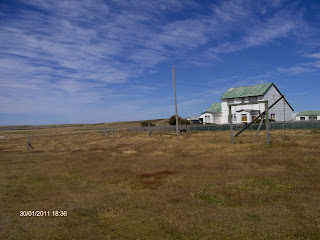Fitzroy, Falklands
Rock Hopper Rockery, Falklands
Rock Hopper Pengiun, Falklands
Queue for Tender at Port Stanley
We arrived in Port Stanley about . It was about 10 C and there was a light rain falling. I was going ashore on my own due to the nature of the tours. They were all unsuitable for Chris. I went on two tours: a trip to see a colony of rock hopper penguins and a tour of the battlefields. Rock hopper penguins are the ones that look like punks with the head crest. I had a 15 minute break between the two tours so I stood a good chance of missing the second. I left the ship on the second tender of the day and we set of from the Falklands quayside at 8.30 in a four wheel drive pickup. To visit the penguins required a 90 minute cross country journey. It was very rough and tough on the spine. We travelled in convoy so they could pull each other out of the mud if they got bogged down. It was the ultimate way to see the countryside which the locals call the camp.
The rock hoppers number about 500 to 600 animals and inhabit a cliff top which seemed wind swept and cold but obvious a palace to penguins. They would let you get within a few feet of them and mainly ignored you. They were noisy with several arguments going on all the time. They seemed to mainly dispute the ownership of small stones and twigs. There were no young birds but many half grown penguins without the rock hopper crest. I managed to video a lot of penguin life since they allow you to get very close to them. The colony is situated on a 10,000 acre sheep farm and the farmer organisers the tours. I wondered why they had chosen a cliff for a colony since it was a long way down to the sea and food. Tourism is basic on the Falklands and the farm have built a one room shack near the colony and made us a cup of tea while the rain past over and the sun came out.
The return journey was as back aching as the initial one but with amazing views of the country of hills, stone piles and small lakes. There are no trees on the Falklands but apparently they are making an effort to plant them. Personally I did not see one. The driver got me back to Port Stanley in times to join the second trip of a visit to the battlefields from 1982 or rather those near Stanley
We then followed the route back to Stanley Stanley Mount Kent Mount Longdon Stanley
As we left the moorings we saw some elephant seals swimming in the sea. They are simply enormous animals. Next dolphins started to follow the ship and finally we saw some seals swimming near some rocks.
Our next stop is Cape Horn which we round tomorrow about . Hopefully we can film the event.




No comments:
Post a Comment